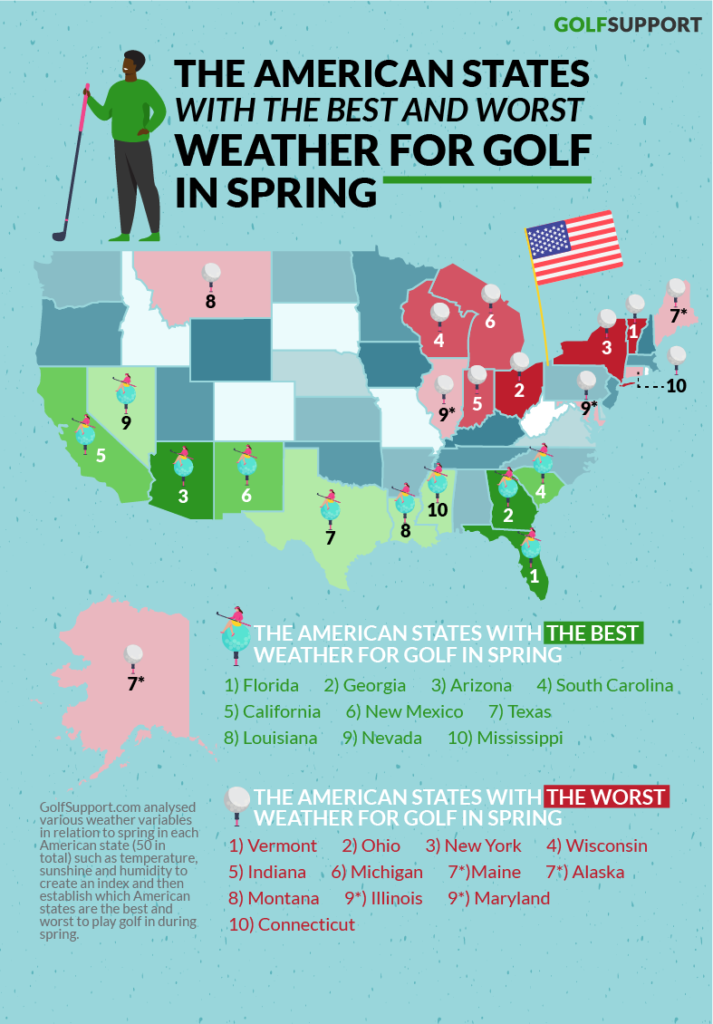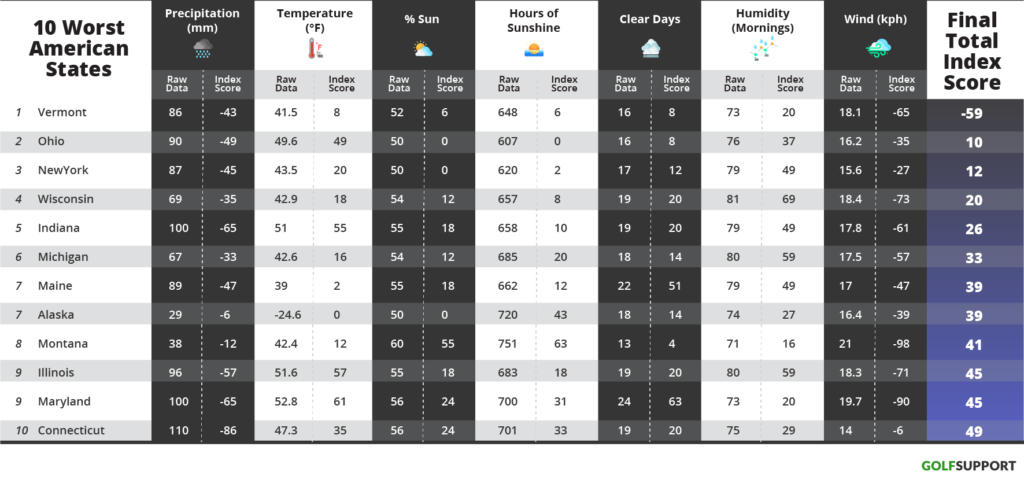The Best and Worst American States for Golf in Spring

Spring is officially here, and many cannot wait to enjoy golf in finer weather conditions. Compared to playing golf in the winter, it will certainly be more pleasant for golfers to enjoy the sports largely due to better temperatures and less chance of unpredictable weather, including snow and rain.
Interested in playing conditions, GolfSupport.com analysed weather conditions to establish which American states are the best and worst to enjoy golf in spring.
For the study, we created an index that considered important spring weather variables for golf such as precipitation (mm), temperature (°F), hours of sunshine, average number of clear days, humidity, and wind speed (kph). The maximum score each state could possibly score was 500.
The results

The American States with the best weather for golf in Spring

We found that Florida is the American state that takes the title for having the best weather conditions for golf in spring. The sunshine state scores a mighty 414 out of 500 in our index. Out of those in the top 10 states, Florida scores the most favourable for the temperature variable at 100, as temperatures can hit a blistering 69.9 °F in spring.
The second-best American state to play golf in spring is Georgia with an index score of 347. Georgia does score very well for humidity in the morning at 92, as there is 85% humidity in the morning hours in the peach state.
Arizona is in third place with a score of 345 points out of 500 in our index. The copper state scores handsomely for variables such as clear days (100 points) and sunshine hours (100 points). With reference to the latter, in spring Arizona benefits from 1,079 hours of sunshine – that is the equivalent of 45 days out of 92 days in spring being dominated by the glorious sun.
South Carolina (334) and California (328) are among the American states that score more than 300 points for their golfing weather conditions during the spring months, respectively ranking fourth and fifth.
Rounding off the top 10 American states to indulge in golf in spring is Mississippi. The hospitality state scores 277 out of 400. Mississippi scores maximum points for humidity (100 points), as there is 90% humidity in the mornings.
The American States with the worst weather for golf in Spring

Vermont is the worst American state to enjoy golf in spring, scoring -59. Vermont scores particularly poorly in the temperature and wind (kph) category, scoring eight and -65 respectively for the two categories. The average temperature in Vermont in spring is 41.5 °F, whilst wind speed is 18.1mph.
In second position is Ohio with a score of just 10. The buckeye state scores particularly poorly for clear days (eight) and sunshine hours (zero). This means out of 92 days in spring, Ohio only gets 16 clear days and 25 days of sunshine.
New York is in third place with a score of 12 in the index. The big apple does score unfavourably for temperature (20 points) and sunshine hours (2 points). In spring, the average temperature in New York is 43.5 °F and only 620 hours of sunshine – comparable to 26 days of sunshine out of 92 in spring.
Wisconsin (20) and Indiana (26) are among the other American states that score less than 30 in the index, respectively in fourth and fifth spot.
In tenth place is Connecticut with a score of 49. The nutmeg state suffers from a lack of clear days (20 points) and humidity in the mornings (29 points). In spring, humidity is 75% in the mornings in Connecticut, whilst there are only 19 clear days out of 92 in spring.
Why weather matters in golf:
- Humidity – The more humid and warmer it is the further a golf ball will travel when in flight.
- Temperature – For every ten degrees a golfer can roughly expect a change of a yard when the golf ball is in flight.
- Temperature – Lower temperatures will mean golfers wear more layers of clothing which can contribute towards a more restricted swing with an iron, driver or wedge.
- Rainy conditions – Rainy and wet conditions will cause a golf ball to stick more on the soft ground as opposed to the firm part of the turf (which lets the ball run farther).
- Rainy conditions – The moisture caused by excessive rain can also impact the spin on a golf ball.
- Wind – The windier it is the more difficult it becomes for a golfer to maintain balance, which is essential for achieving a good golf swing.
- Wind – The colder the air is the more chance lift and drag forces will play their part in affecting a golf ball, causing slightly higher and shorter trajectory.
Methodology for the research:
- GolfSupport sourced average spring climate data from https://www.currentresults.com/index.php. The data are based on results made available by the NOAA National Climatic Data Center of the United States.
- Temperature - state-wide averages calculated from temperatures recorded during the months of March, April, May, and June (i.e. spring months). The results are measured in Fahrenheit (°F).
- Precipitation - state-wide averages for the amount of rain and snowfall per month in spring. Results are shown in millimetres.
- % sun number measures the percentage of time between sunrise and sunset that sunshine reaches the ground.
- Total Hours is the average number of sunny hours a state normally has in spring .
- Clear days is the average number of days in spring when cloud covers at most 30 per cent (%) of the sky during daylight hours.
- Wind - shows the average annual wind speed by state in mph. Therefore, it is assumed the annual average is the same during the spring months. Sourced from http://www.usa.com/rank/us--average-wind-speed--state-rank.htm
- Data for all measures have been standardised using the PERCENTRANK.INC function in Excel. This ranks the figures of each number within a given factor between 0 and 100. Further, the measures that are assumed to have a negative impact on the golfing experience (e.g. precipitation, wind, etc.) are multiplied by -1 to reflect this. The maximum score possible is 500.
Feature Image Credit: Krivosheev Vitaly / Shutterstock








